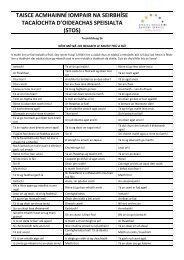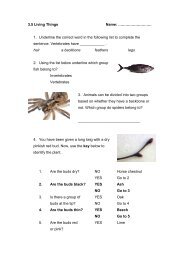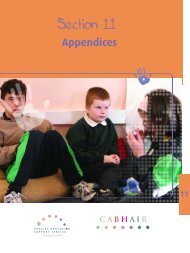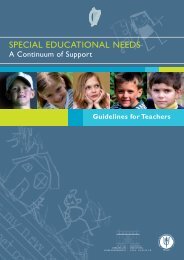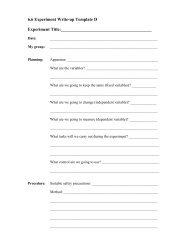TOPIC 2.7: States of Matter (Learning outcomes by syllabus ...
TOPIC 2.7: States of Matter (Learning outcomes by syllabus ...
TOPIC 2.7: States of Matter (Learning outcomes by syllabus ...
Create successful ePaper yourself
Turn your PDF publications into a flip-book with our unique Google optimized e-Paper software.
<strong>TOPIC</strong> <strong>2.7</strong>:<br />
HOW MANY<br />
LESSONS?<br />
<strong>States</strong> <strong>of</strong> <strong>Matter</strong> (<strong>Learning</strong> <strong>outcomes</strong> <strong>by</strong> <strong>syllabus</strong><br />
reference: OC1)<br />
1 – 2 lessons<br />
KEYWORDS / TERMS TO BE TAUGHT<br />
<strong>Matter</strong> Solid Liquid Gas<br />
Mass Melting Compressed Freezing<br />
Particles Condensing Evaporating<br />
KEY CONCEPTS IN THE LESSON (OBJECTIVES)<br />
What students must<br />
know or be able to do<br />
What students should<br />
know or be able to do<br />
What students could<br />
know or be able to do<br />
To be able to identify To be able to identify all<br />
To be able to discuss<br />
solids, liquids and the properties <strong>of</strong> solids,<br />
changes <strong>of</strong> state in<br />
gases, and their main liquids and gases<br />
terms <strong>of</strong> the energy <strong>of</strong><br />
properties<br />
To be able to identify<br />
molecules<br />
changes <strong>of</strong> state<br />
SEQUENCE OF LESSON<br />
1. Introduce the concept <strong>of</strong> matter. Allow students to relate personal<br />
experiences <strong>of</strong> solids, liquids and gases. This could be facilitated <strong>by</strong> using<br />
the <strong>States</strong> <strong>of</strong> <strong>Matter</strong> Introduction PowerPoint and encouraging student input<br />
during the presentation.<br />
2. Carry out experimental activities (changes <strong>of</strong> state) in groups with a<br />
focus on safety. Discussion <strong>of</strong> key vocabulary, risks and safety rules<br />
3. Review – whole class discussion. Possibility <strong>of</strong> using <strong>States</strong> <strong>of</strong> <strong>Matter</strong><br />
Quiz PowerPoint to facilitate student understanding.<br />
4. Further class work/homework – see <strong>States</strong> <strong>of</strong> <strong>Matter</strong> Worksheet.<br />
1. DIFFERENTIATE BY CONTENT (In what ways can I vary the content <strong>of</strong><br />
what I am teaching?)<br />
(A) Complexity <strong>of</strong> content: (concrete, symbolic, abstract)<br />
Concrete Symbolic Abstract
Real materials<br />
associated with matter<br />
(e.g. ice, water in a<br />
beaker, steam, wax,<br />
sand, blocks <strong>of</strong> wood<br />
or metal, air in a<br />
balloon)<br />
(B) Variety <strong>of</strong> resources<br />
Particle arrangements<br />
in solids, liquids and<br />
gases<br />
Movement <strong>of</strong> particles in<br />
solids, liquids and gases<br />
and during changes <strong>of</strong><br />
state<br />
As listed above<br />
(C) Variety <strong>of</strong> learning environments<br />
Classroom, school laboratory, computer room<br />
2. DIFFERENTIATE BY PROCESS (How will I teach the lesson?)<br />
Sequence <strong>of</strong> lesson as laid out above<br />
Introduction – using concrete material or a general class discussion<br />
Teacher may demonstrate use <strong>of</strong> apparatus to the class, emphasising<br />
safety.<br />
Closely observe students as they perform changes <strong>of</strong> state activities<br />
individually or in pairs. For resources, guidance and support related to<br />
facilitating student experiments and investigations, see<br />
www.juniorscience.ie<br />
Possible use <strong>of</strong> <strong>States</strong> <strong>of</strong> <strong>Matter</strong> Quiz PowerPoint to facilitate<br />
discussion<br />
3. DIFFERENTIATE BY OUTCOME / PRODUCT<br />
(How will the student demonstrate understanding?)
See Worksheets, Classroom Activities and Experiments sections <strong>of</strong> this<br />
resource pack.<br />
• Students may draw particles representing solids, liquids and gases in<br />
their copies and/or short descriptions <strong>of</strong> how these molecules behave.<br />
• Offer students a choice <strong>of</strong> learning activities. Students may design a<br />
poster, write a poem/song or create a radio documentary on tape<br />
describing how molecules behave in solids, liquids and gases.<br />
• Whole class review work completed at end <strong>of</strong> class.<br />
• Homework: <strong>States</strong> <strong>of</strong> <strong>Matter</strong> Worksheet if not used for class work.<br />
Specify time to be allocated to this work at home<br />
FINALLY - ANY OTHER POSSIBILITIES FOR THIS LESSON?<br />
• Common changes <strong>of</strong> state in everyday life<br />
• Collage <strong>of</strong> scenes showing solids, liquids and gases<br />
• Role play using students as individual particles in solids, liquids and<br />
gases<br />
• Other written activities, e.g. a log <strong>of</strong> the different types <strong>of</strong> matter in the<br />
room<br />
• Extension exercise: Where would you not find matter?<br />
• For advice on enhancing curricular access through the use <strong>of</strong> mobile<br />
ICT, see www.laptopsinitiative.ie


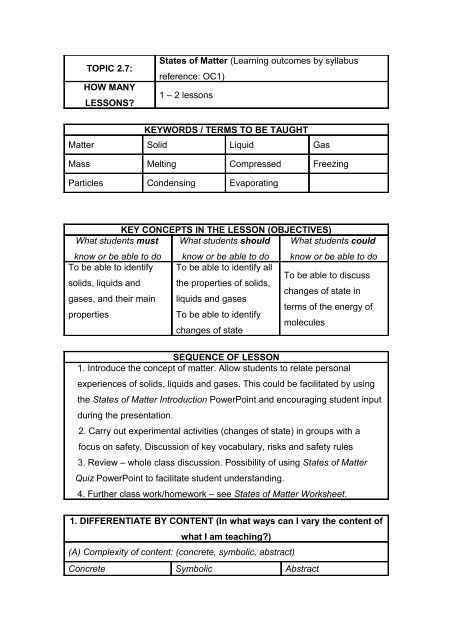

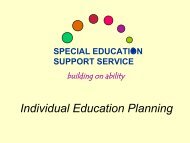
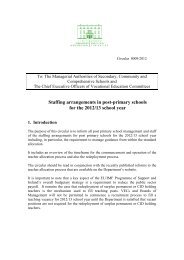

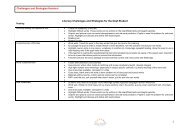
![to download [PDF, 98KB]](https://img.yumpu.com/50090201/1/184x260/to-download-pdf-98kb.jpg?quality=85)


